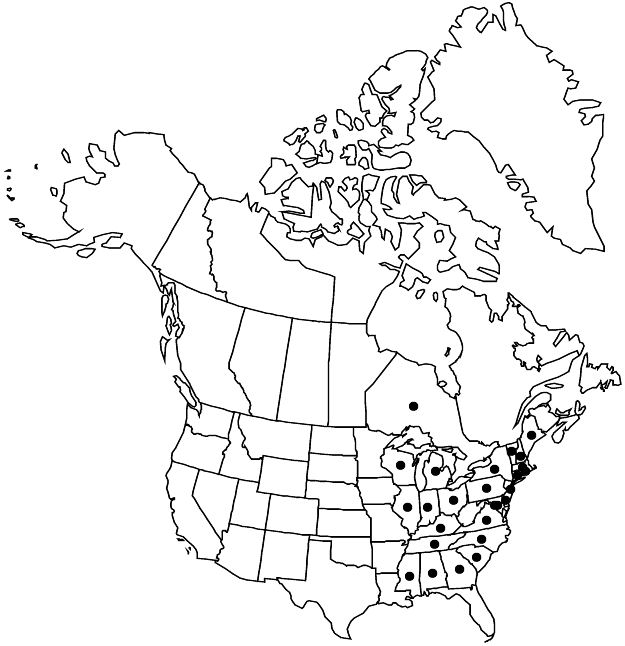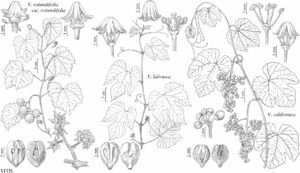Vitis labrusca
Sp. Pl. 1: 203. 1753.
Plants high climbing, sparsely branched. Branches: bark exfoliating in shreds; nodal diaphragms 0.5–2.5 mm thick; branchlets terete, densely tomentose to arachnoid-floccose or glabrous, sometimes with spinose, gland-tipped hairs, growing tips not enveloped by unfolding leaves; tendrils along length of branchlets, persistent, branched, tendrils (or inflorescences) at almost all nodes; nodes not red-banded. Leaves: stipules 2–4 mm; petiole ± equaling blade; blade cordate, usually 3-shouldered, sometimes unlobed or deeply 3 (–5) -lobed, 10–20 cm, apex usually acute, abaxial surface not glaucous, densely and persistently arachnoid, concealed (except sometimes veins) by hairs, adaxial surfaces glabrous or sparsely pubescent. Inflorescences 6–14 cm. Flowers functionally unisexual. Berries black, usually not, sometimes slightly, glaucous, globose, 12+ mm diam., skin separating from pulp; lenticels absent. 2n = 38.
Phenology: Flowering May–Jun; fruiting Sep–Oct.
Habitat: Upland and lowland woods and forests, intermittently flooded bottomlands, forest edges, thickets, roadsides.
Elevation: 0–2000 m.
Distribution

Ont., Ala., Conn., Del., D.C., Ga., Ill., Ind., Ky., Maine, Md., Mass., Mich., Miss., N.H., N.J., N.Y., N.C., Ohio, Pa., R.I., S.C., Tenn., Vt., Va., Wis.
Discussion
Hybrids between Vitis labrusca and V. vinifera, such as "Concord," are widely cultivated. The Concord grape is the result of crosses with V. vinifera as the maternal parent and V. labrusca as the paternal parent, with the F1 backcrossed with V. labrusca as the paternal parent (J. Wen, unpubl.). Vitis ×labruscana L. H. Bailey is the name applied to these hybrids between V. labrusca and V. vinifera, some of which have escaped from cultivation and become naturalized in New Brunswick, Nova Scotia, Utah, and western British Columbia, Oregon, and Washington.
Selected References
None.
Lower Taxa
"connate" is not a number.
